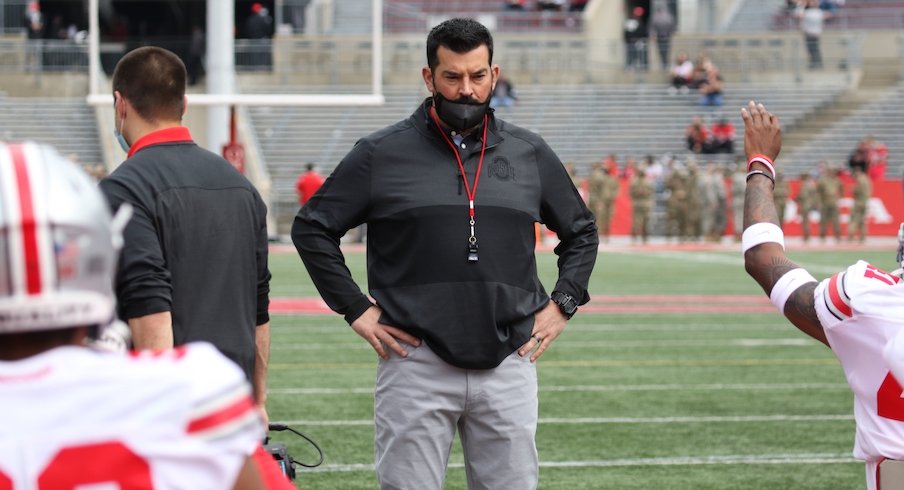The last football season was anything but normal. Mark Pantoni, Ohio State’s associate athletic director of player personnel, knows that as well as anybody.
In a typical fall, he’s knee-deep in recruiting. Visitors come pouring into Columbus on a weekly basis, high school games in 50 states are being played and scouted and the coaching staff is taking visits to see prospects in person. Rarely do things settle down.
In 2021, however, the impact of COVID-19 on college football recruiting left Pantoni with more time on his hands than usual. So, he figured out a different way to scout; he scouted college football players instead of high school players. The long-time leader of the recruiting department began to put scouting reports together on the upcoming teams’ on the Buckeyes schedule.
Doing so, he took a new line of thinking to the exercise: What if some of these opposing players transfer at some point down the line?
“I spent a lot of time scouting our opponents, which is good because now with this one-time transfer rule, now I have notes on every team we played,” Pantoni said on Friday morning. “I would take notes on other players so if they now enter the portal, at least I've graded guys and got the head start that way.”
That’s a line of thinking that’s new to college football staffers, but it’s one that’ll become commonplace in the industry.
The implementation of the transfer portal two years ago began streamlining the recruitment of transfers, and the approval of the new rule allowing all players to transfer once without sitting out will only work to increase the number of players jumping from program to program. The transfer craze has already arrived in college basketball, and it’s only a matter of time until the roster movement across college football teams jumps, as well.
Ohio State, of course, has in turn ramped up its evaluation of potential targets already playing at the collegiate level.
Pantoni said keeping an eye on the portal entrants and understanding what they might offer the Buckeyes has “definitely become bigger” for him and his staff of late.
“Probably spending a few hours a day now watching guys as they enter the portal,” Pantoni said. “Just always looking for if there's someone who can help the roster, we'll bring them in. Whether it's FBS, FCS, we're just trying to make sure. Probably a couple of hours every single day now I'm watching college film rather than high school film. It's been a transition.”
The question now, of course, is whether that transition will lead to Ohio State doing more than dabbling in the transfer market.
During Day’s tenure, the Buckeyes have taken a pragmatic approach to the portal. They have tried not to overuse it and to only use it to fill immediate needs.
When they didn’t have a great solution at quarterback, they went out and landed Justin Fields. When they needed more depth behind him, they brought Gunnar Hoak back to his hometown team. When they felt as though they had a hole on the interior of their offensive line, they grabbed Jonah Jackson and stuck him in as a one-year plug-and-play guard. When their running back room was down to a single healthy scholarship player, they went after Trey Sermon.
Their strategy of only using the portal to fill immediate needs with impact players has been evident for a while. Will it change? Will Ohio State instead recruit fewer high school players and lean heavier on the transfer market?
At least as of now, Pantoni said, there won’t be any wholesale changes.
“We'll still go about as business as is because there's just natural attrition every year,” Pantoni said. “There's always guys, something happens you never expect. Maybe one spot, maybe two, but we're not going to try to purposely leave spots just because there's always going to be that natural attrition.”
Over time, perhaps the Buckeyes become more involved. For example, the blue bloods of college basketball weren’t the early adopters of the transfers portal, but as it has increasingly become en vogue, they – especially Kentucky this offseason – have used it more frequently.
For now, per Pantoni, Ohio State’s spending its time in the transfer portal looking for much of the same: Instant-impact players who showed out at their last stop.
“They're just a little bit more developed (than high schoolers), but skillset-wise you're still looking at the same critical factors and everything and how productive were they for the team,” Pantoni said. “Obviously a guy who was a backup at the school they left and didn't have much film, probably not going to be a guy for us.
“We're looking at guys who've had success at their old school and maybe will be able to help us like Jonah and Trey and Justin were home runs for us.”


